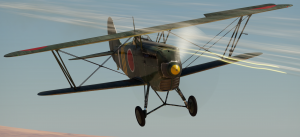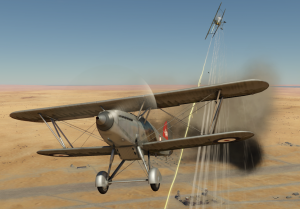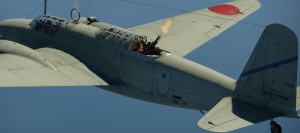Difference between revisions of "Type 89 (7.7 mm)"
(Edits) |
(→Available ammunition: Updated) |
||
| (9 intermediate revisions by 6 users not shown) | |||
| Line 1: | Line 1: | ||
| + | {{About | ||
| + | | about = '''{{PAGENAME}}''' | ||
| + | | usage = equipment of the same adoption year | ||
| + | | link = Type 89 (Disambiguation) | ||
| + | }} | ||
== Description == | == Description == | ||
<!-- ''Write an introduction to the article in 2-3 small paragraphs. Briefly tell us about the history of the development and combat using the weaponry and also about its features. Compile a list of air, ground, or naval vehicles that feature this weapon system in the game.'' --> | <!-- ''Write an introduction to the article in 2-3 small paragraphs. Briefly tell us about the history of the development and combat using the weaponry and also about its features. Compile a list of air, ground, or naval vehicles that feature this weapon system in the game.'' --> | ||
[[File:Ki-10-II C firing Type 89s.png|thumb|The Type 89s are common on lower tier biplanes like the [[Ki-10-II C]]]] | [[File:Ki-10-II C firing Type 89s.png|thumb|The Type 89s are common on lower tier biplanes like the [[Ki-10-II C]]]] | ||
| − | The Type 89 is the IJA's standard issue machine gun, similar to the [[Vickers E (7.7 mm)|Vickers E]] machine gun. Note that the Type 89 is indistinguishable from the IJN's [[Type 97 (7.7 mm)|Type 97]], so you can expect the same belts and performance from the two. These guns have a lower rate of fire than other rifle-calibre machine guns, have decent ballistics, and have low jamming probability when upgraded. However, the total damage output of these guns is rather low, and you'll have to deal with poor belts and terrible rounds. These guns have one strong side at lower BRs however. Compared to the [[Type 92 (7.7 mm)|Type 92]], the flexible 89 is a great defensive turret. On planes like the | + | The Type 89 is the IJA's standard issue machine gun, similar to the [[Vickers E (7.7 mm)|Vickers E]] machine gun. Note that the Type 89 is indistinguishable from the IJN's [[Type 97 (7.7 mm)|Type 97]], so you can expect the same belts and performance from the two. These guns have a lower rate of fire than other rifle-calibre machine guns, have decent ballistics, and have low jamming probability when upgraded. However, the total damage output of these guns is rather low, and you'll have to deal with poor belts and terrible rounds. These guns have one strong side at lower BRs however. Compared to the [[Type 92 (7.7 mm)|Type 92]], the flexible 89 is a great defensive turret. On planes like the Ki-32 and F1M2, these guns wreak havoc due to the sheer number of AP rounds in the belt, which tear through biplanes. |
=== Vehicles equipped with this weapon === | === Vehicles equipped with this weapon === | ||
| Line 17: | Line 22: | ||
{{Navigation-Line|Ki-61}}{{Specs-Link|ki_61_1a_ko}} | {{Navigation-Line|Ki-61}}{{Specs-Link|ki_61_1a_ko}} | ||
| − | {{Navigation | + | {{Navigation-Line|'''Bombers'''}}{{Specs-Link|ki_32}}{{-}}{{Specs-Link|ki-49_1}} (Defensive){{-}}{{Specs-Link|ki-49_2a}} (Defensive){{-}}{{Specs-Link|ki-49_2b}} (Defensive){{-}}{{Specs-Link|ki-49_2b_late}} (Defensive) |
| + | |||
| + | {{Navigation-First-Line|'''Armoured gun boats'''}}{{Specs-Link|jp_abtei_pr4}} | ||
| + | {{Navigation-Line|'''Destroyers'''}}{{Specs-Link|jp_destroyer_momi}} | ||
{{Navigation-End}} | {{Navigation-End}} | ||
| Line 27: | Line 35: | ||
=== Available ammunition === | === Available ammunition === | ||
<!-- ''Describe the shells that are available for the weapon and their features and purpose. If it concerns autocannons or machine guns, write about different ammo belts and what is inside (which types of shells).'' --> | <!-- ''Describe the shells that are available for the weapon and their features and purpose. If it concerns autocannons or machine guns, write about different ammo belts and what is inside (which types of shells).'' --> | ||
| − | Default: T | + | '''Aircraft''' |
| + | |||
| + | * '''Default:''' {{Annotation|T|Tracer}}{{-}}{{Annotation|AP|Armour-piercing}}{{-}}{{Annotation|IAI|Immediate-action incendiary}}{{-}}{{Annotation|AP|Armour-piercing}}{{-}}{{Annotation|I|Incendiary}} | ||
| + | * '''Universal:''' {{Annotation|T|Tracer}}{{-}}{{Annotation|AP|Armour-piercing}}{{-}}{{Annotation|IAI|Immediate-action incendiary}}{{-}}{{Annotation|AP|Armour-piercing}} | ||
| + | * '''Tracers:''' {{Annotation|T|Tracer}}{{-}}{{Annotation|T|Tracer}}{{-}}{{Annotation|T|Tracer}}{{-}}{{Annotation|AP|Armour-piercing}} | ||
| + | * '''Stealth:''' {{Annotation|I|Incendiary}}{{-}}{{Annotation|AP|Armour-piercing}}{{-}}{{Annotation|AP|Armour-piercing}}{{-}}{{Annotation|AP|Armour-piercing}}{{-}}{{Annotation|IAI|Immediate-action incendiary}} | ||
| − | + | Stealth is a great choice because your enemy won't see you coming, and these guns are always mounted in the nose (except on the B6N1 Model 11 and Ki-32) and are easy to aim. Stealth won't often light fires, but its AP rounds will get to work and sooner or later hit the pilot or snap off a wing. | |
| − | + | * '''Default (turret):''' {{Annotation|T|Tracer}}{{-}}{{Annotation|IAI|Immediate-action incendiary}}{{-}}{{Annotation|Ball|Omni-purpose}}{{-}}{{Annotation|AP|Armour-piercing}}{{-}}{{Annotation|AP|Armour-piercing}}{{-}}{{Annotation|I|Incendiary}} | |
| + | * '''Armoured targets (turret):''' {{Annotation|T|Tracer}}{{-}}{{Annotation|AP|Armour-piercing}}{{-}}{{Annotation|AP|Armour-piercing}}{{-}}{{Annotation|AP|Armour-piercing}} | ||
| + | * '''AP-T (turret):''' {{Annotation|T|Tracer}}{{-}}{{Annotation|AP|Armour-piercing}} | ||
| − | + | '''Naval vessels''' | |
| − | + | * '''Universal:''' {{Annotation|AP|Armour-piercing}}{{-}}{{Annotation|T|Tracer}}{{-}}{{Annotation|AP|Armour-piercing}}{{-}}{{Annotation|T|Tracer}}{{-}}{{Annotation|AP|Armour-piercing}}{{-}}{{Annotation|T|Tracer}}{{-}}{{Annotation|AP|Armour-piercing}}{{-}}{{Annotation|T|Tracer}} | |
| + | * '''7.7 mm AP belt:''' {{Annotation|AP|Armour-piercing}}{{-}}{{Annotation|AP|Armour-piercing}}{{-}}{{Annotation|AP|Armour-piercing}}{{-}}{{Annotation|T|Tracer}}{{-}}{{Annotation|AP|Armour-piercing}}{{-}}{{Annotation|AP|Armour-piercing}}{{-}}{{Annotation|AP|Armour-piercing}}{{-}}{{Annotation|T|Tracer}} | ||
| + | * '''7.7 mm API belt:''' {{Annotation|IT|Incendiary tracer}}{{-}}{{Annotation|IT|Incendiary tracer}}{{-}}{{Annotation|IT|Incendiary tracer}}{{-}}{{Annotation|AP|Armour-piercing}}{{-}}{{Annotation|IT|Incendiary tracer}}{{-}}{{Annotation|IT|Incendiary tracer}}{{-}}{{Annotation|IT|Incendiary tracer}}{{-}}{{Annotation|AP|Armour-piercing}} | ||
=== Comparison with analogues === | === Comparison with analogues === | ||
| Line 64: | Line 81: | ||
* Low damage output | * Low damage output | ||
| − | * Bad | + | * Bad belts |
* Wont do anything to bombers | * Wont do anything to bombers | ||
* No incendiary potential | * No incendiary potential | ||
== History == | == History == | ||
| − | ''Examine the history of the creation and combat usage of the weapon in more detail than in the introduction. If the historical reference turns out to be too long, take it to a separate article, taking a link to the article about the weapon and adding a block "/History" (example: <nowiki>https://wiki.warthunder.com/(Weapon-name)/History</nowiki>) and add a link to it here using the <code>main</code> template. Be sure to reference text and sources by using <code><nowiki><ref></ref></nowiki></code>, as well as adding them at the end of the article with <code><nowiki><references /></nowiki></code>.'' | + | <!-- ''Examine the history of the creation and combat usage of the weapon in more detail than in the introduction. If the historical reference turns out to be too long, take it to a separate article, taking a link to the article about the weapon and adding a block "/History" (example: <nowiki>https://wiki.warthunder.com/(Weapon-name)/History</nowiki>) and add a link to it here using the <code>main</code> template. Be sure to reference text and sources by using <code><nowiki><ref></ref></nowiki></code>, as well as adding them at the end of the article with <code><nowiki><references /></nowiki></code>.'' --> |
| + | The Imperial Japanese Army Air Service had the Type 89 as a designation for two aircraft machine guns, a fixed model (detailed here) and a flexible mount ([[Type 89 'special' (7.7 mm)]]) that were two very different guns with different origins. The fixed Type 89 is a Japanese copy of the [[Vickers E (7.7 mm)|Vickers Class E]] which was an airborne version of a World War I-era machine gun converted to be air-cooled. It was positioned in the wings of fighters or in engine cowlings where it was synchronized with the propeller. Preserved examples of the fixed Type 89 show that it was used in ground vehicles along with aircraft, notably the Type 97 Te-Ke tankette. The machine gun was also used on the [[Ki-27 (Family)|Ki-27]] "Nate", [[Ki-43 (Family)|Ki-43 Hayabusa]], and [[Ki-44-I]] Shoki fighters along with the Mitsubishi Ki-30 "Ann" light bomber, Ki-51 "Sonia" dive bomber, and the [[Ki-32]] "Mary" light bomber. After World War II, some Type 89 fixed guns saw use by Communist forces during the Korean War. | ||
== Media == | == Media == | ||
| Line 88: | Line 106: | ||
{{Aircraft machine guns}} | {{Aircraft machine guns}} | ||
| + | {{Naval machine guns}} | ||
[[Category:Aircraft machine guns]] | [[Category:Aircraft machine guns]] | ||
| + | [[Category:Naval machine guns]] | ||
Latest revision as of 12:50, 23 September 2023
| This page is about the Type 89 (7.7 mm). For equipment of the same adoption year, see Type 89 (Disambiguation). |
Contents
Description

The Type 89 is the IJA's standard issue machine gun, similar to the Vickers E machine gun. Note that the Type 89 is indistinguishable from the IJN's Type 97, so you can expect the same belts and performance from the two. These guns have a lower rate of fire than other rifle-calibre machine guns, have decent ballistics, and have low jamming probability when upgraded. However, the total damage output of these guns is rather low, and you'll have to deal with poor belts and terrible rounds. These guns have one strong side at lower BRs however. Compared to the Type 92, the flexible 89 is a great defensive turret. On planes like the Ki-32 and F1M2, these guns wreak havoc due to the sheer number of AP rounds in the belt, which tear through biplanes.
Vehicles equipped with this weapon
| Vehicles equipped with this weapon | |
|---|---|
| Fighters | |
| A5M4 | A5M4 · Hagiri's A5M4 |
| Ki-10 | Ki-10-I · Ki-10-I C · Ki-10-II · Ki-10-II C |
| Ki-27 | Ki-27 otsu · Ki-27 otsu Tachiarai · ␗Ki-27 otsu |
| Ki-43 | Ki-43-I |
| Ki-44 | Ki-44-I · Ki-44-I 34 |
| Ki-61 | Ki-61-I ko |
| Bombers | Ki-32 · Ki-49-I (Defensive) · Ki-49-IIa (Defensive) · Ki-49-IIb (Defensive) · Ki-49-IIb/L (Defensive) |
| Armoured gun boats | Soukou-Tei No.4 |
| Destroyers | IJN Momi |
General info
Tell us about the tactical and technical characteristics of the cannon or machine gun.
Available ammunition
Aircraft
- Default: T · AP · IAI · AP · I
- Universal: T · AP · IAI · AP
- Tracers: T · T · T · AP
- Stealth: I · AP · AP · AP · IAI
Stealth is a great choice because your enemy won't see you coming, and these guns are always mounted in the nose (except on the B6N1 Model 11 and Ki-32) and are easy to aim. Stealth won't often light fires, but its AP rounds will get to work and sooner or later hit the pilot or snap off a wing.
- Default (turret): T · IAI · Ball · AP · AP · I
- Armoured targets (turret): T · AP · AP · AP
- AP-T (turret): T · AP
Naval vessels
- Universal: AP · T · AP · T · AP · T · AP · T
- 7.7 mm AP belt: AP · AP · AP · T · AP · AP · AP · T
- 7.7 mm API belt: IT · IT · IT · AP · IT · IT · IT · AP
Comparison with analogues
Not many weapons rival the poor firepower of this gun, but some reserve machine guns like the Mle 33 or MAC 1934 are worse. German rifle-calibres will always outperform it and often set fires, while British machine guns are very similar in performance. The American Browning jams very quickly, so keep that in mind, as you are still superior to other nations in terms of the rifle-calibre machine guns.
- MAC 1934: Bad firepower compared to the 89s, but excellent rate of fire
- Browning/Swedish Browning: Better firepower, however it is quick to jam
- MG 15/17/81: Better firepower, belts, rate of fire, and performance
- ShKAS: Jam very quickly, poor accuracy
Usage in battles
These guns suffer from stock belts, however no other belt option has too much of a difference. These guns rely less on getting shots in but rather on chipping away at the most vital parts of the plane. The opponents you will face with these guns are almost always unarmoured biplanes or early monoplanes. However, early bombers will brush off these bullets easily, you may empty your entire ammo stowage before destroying a single bomber. One excellent tactic is aiming for the wings or engines, but most importantly, pilots. You need to remember that at higher BRs, these guns do little, so don't rely on them for anything when you have cannons available to use, though they can be used to knock out ground targets while saving your precious cannon ammunition.
Pros and cons
Pros:
- Mounted in the nose, unlike British and some German counterparts
- Good turret firepower at lower BR
- Good ammo count
- Won't jam too quickly
Cons:
- Low damage output
- Bad belts
- Wont do anything to bombers
- No incendiary potential
History
The Imperial Japanese Army Air Service had the Type 89 as a designation for two aircraft machine guns, a fixed model (detailed here) and a flexible mount (Type 89 'special' (7.7 mm)) that were two very different guns with different origins. The fixed Type 89 is a Japanese copy of the Vickers Class E which was an airborne version of a World War I-era machine gun converted to be air-cooled. It was positioned in the wings of fighters or in engine cowlings where it was synchronized with the propeller. Preserved examples of the fixed Type 89 show that it was used in ground vehicles along with aircraft, notably the Type 97 Te-Ke tankette. The machine gun was also used on the Ki-27 "Nate", Ki-43 Hayabusa, and Ki-44-I Shoki fighters along with the Mitsubishi Ki-30 "Ann" light bomber, Ki-51 "Sonia" dive bomber, and the Ki-32 "Mary" light bomber. After World War II, some Type 89 fixed guns saw use by Communist forces during the Korean War.
Media
Excellent additions to the article would be video guides, screenshots from the game, and photos.
See also
Links to the articles on the War Thunder Wiki that you think will be useful for the reader, for example:
- reference to the article about the variant of the cannon/machine gun;
- references to approximate analogues by other nations and research trees.
External links
Paste links to sources and external resources, such as:
- topic on the official game forum;
- encyclopedia page on the weapon;
- other literature.
| Aircraft machine guns | |
|---|---|
| USA | |
| 7.62 mm | Browning · M134 Minigun |
| 12.7 mm | GAU-19 · M2 Browning · M3 Browning |
| Germany | |
| 7.62 mm | MG3 |
| 7.92 mm | MG 15 · MG 17 · MG 81 |
| 12.7 mm | FN M3P |
| 13 mm | MG 131 |
| USSR | |
| 7.62 mm | DA · GShG-7.62 · PKT · PV-1 · ShKAS |
| 12.7 mm | A-12.7 · Berezin UB · TKB-481 · YaK-B |
| Britain | |
| 7.62 mm | FN 60.30 · L8A1 |
| 7.7 mm | Browning · Lewis · Vickers E · Vickers K |
| Japan | |
| 7.7 mm | Te-1 · Type 89 · Type 89 'special' · Type 92 · Type 97 navy |
| 7.92 mm | Type 1 · Type 98 |
| 12.7 mm | Ho-103 · Ho-104 |
| 13 mm | Type 2 |
| 13.2 mm | Type 3 |
| China | |
| 12.7 mm | QJK99-12.7-1 |
| Italy | |
| 7.7 mm | Breda-SAFAT · Lewis |
| 7.92 mm | FN Browning |
| 12.7 mm | Breda-SAFAT · FN M3M · Scotti |
| France | |
| 7.5 mm | Darne 1933 · Fabrique Nationale Mle 38 · FN Browning · MAC 1934 · MAC 1934T · Mle 33 · Mle 1923 |
| 7.62 mm | PKA |
| Sweden | |
| 7.7 mm | FN-Browning M.36 No.3 |
| 8 mm | Ksp m/22 · Ksp m/22 Fh · Ksp m/22 Fv · Ksp m/22-37 R |
| 12.7 mm | Akan m/39A · Akan m/40 · Akan m/45 · LKk/42 |
| 13.2 mm | Akan m/39 · Akan m/39A |
| Naval machine guns | |
|---|---|
| USA | |
| 7.62 mm | M73 |
| 12.7 mm | AN-M2 |
| Germany | |
| 7.62 mm | MG-3 |
| 7.92 mm | MG08 pattern 1908 · MG15 · MG34 |
| 13.2 mm | Hotchkiss |
| 15 mm | MG M38(t) |
| USSR | |
| 7.62 mm | Maxim |
| 12.7 mm | DShK |
| 14.5 mm | KPV |
| Britain | |
| 7.62 mm | FN MAG |
| 7.7 mm | Lewis 1916 · Vickers GO No.5 |
| 12.7 mm | Vickers Mk.V |
| Japan | |
| 6.5 mm | Maxim · Type 38 pattern 1907 |
| 7.7 mm | Type 89 · Type 92 |
| 13.2 mm | Type 93 |
| Italy | |
| 6.5 mm | Breda Mod.30 · Fiat Model 26 |
| 12.7 mm | Breda-SAFAT |
| 13.2 mm | Breda Model 31 |
| France | |
| 13.2 mm | Browning · Model 1929 Hotchkiss |





